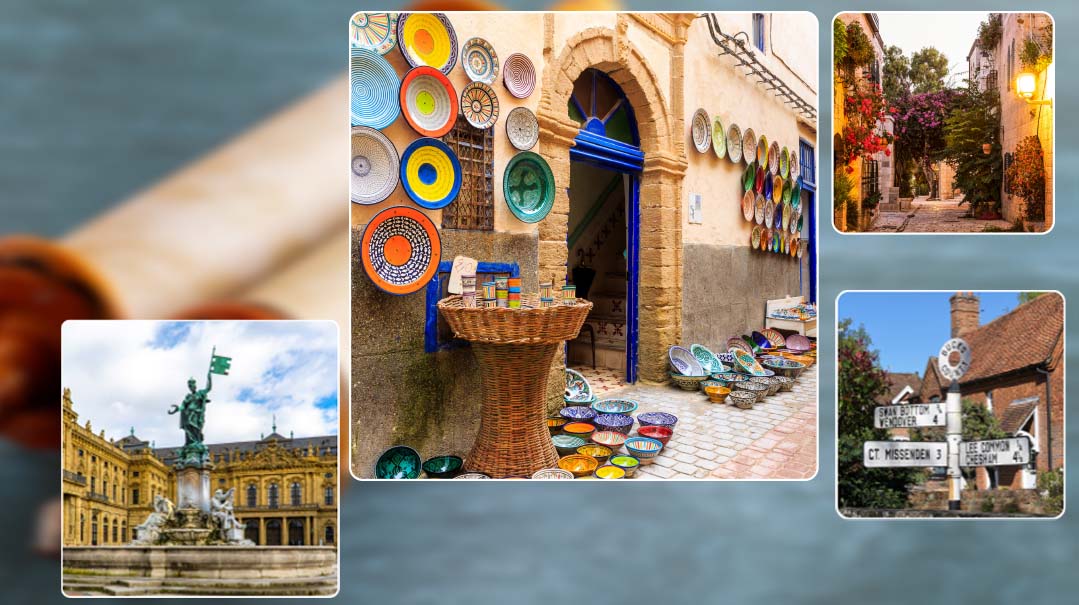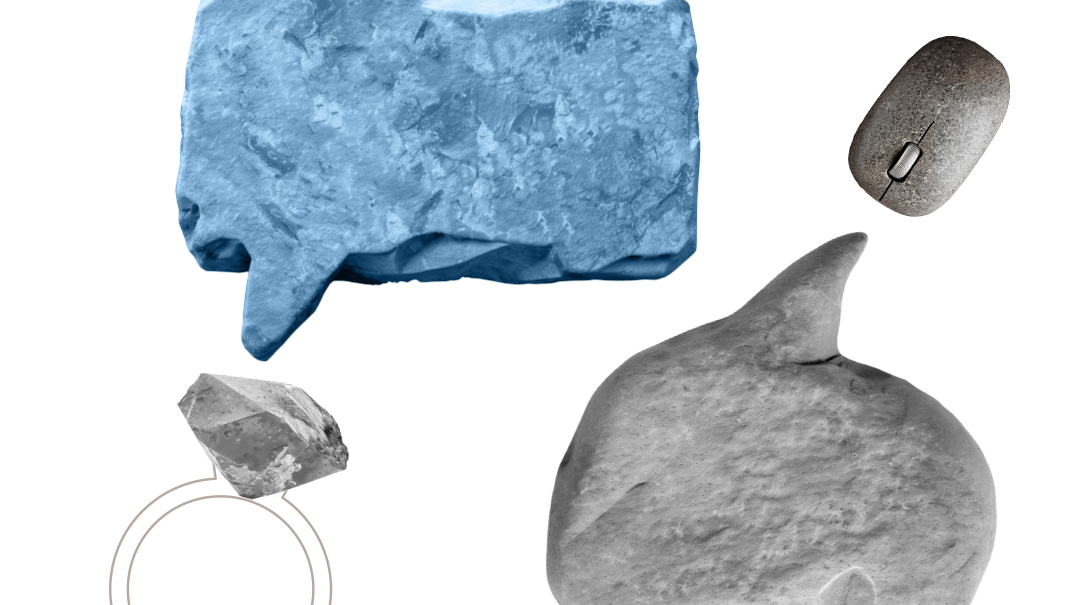For the Sake of His Children

For over a century, Rebbetzin Malka Waltner and her husband traversed the globe on their mission to bring Torah to every Jewish child

"Look out through my window. Did you ever see anything so beautiful?”
I follow Rebbetzin Malka Waltner’s finger as she points to the panoramic view of Yerushalayim visible from her living room. I glance toward the window and then look back at the bright, intelligent eyes of a centenarian woman who has seen Germany and London, Gateshead and Morocco, Gibraltar and Belgium.
The Rebbetzin’s heart is a repository of stories from different times, and the silhouettes of yesterday’s greatness accompany her through her days. The view, indeed, is beautiful.
“It’s worth everything, no? When I have this, I don’t need anything else.”
I’ve come greedy for stories. A consummate hostess, the Rebbetzin, however, is absorbed first in offering me drinks and hearing about my journey.
“So, you want to hear about my husband?”
I shake my head. “No, Rebbetzin Waltner. I came here to hear about you.”
“About me?”
“Yes.”
“Well, then no one is going to read it. Why would anyone want to read about me?”
I looked around the room, filled with mementos from around the world, and looked back into the eyes of this centenarian, bright with intelligence and humor. In German accented English, spiced with Hebrew and the occasional Yiddish, she has already questioned me on my travel arrangements (applauding my decision to travel by bus — “Here they drive like meshugaim”) and asked if her acquaintance, Mishpacha’s CEO Eli Paley will check the article himself (answer: “He has people who will check it for him”).
No one will want to read it? I smile and shake my head. “I don’t think so.”
Close Escape
How my mother developed her resilience, says her daughter Rebbetzin Golovenshitz, then you need to go back to her youth in Würzberg, Germany. Born into a wealthy, established family, the young Malka Habermann was only a teen when her mother passed away in 1934. Her two older sisters were living in Paris, and they urged her to join them, along with their father. But Malka had other plans.
Hitler’s soldiers may have been goose-stepping over the bridges of the Rhine, but Rebbetzin Waltner was slaking her intellectual and spiritual thirst in the famed Würzberg Teacher’s Seminary. The teaching staff featured the most prominent rabbanim of the day, and the pedagogical standards — recognized by the secular authorities — were famed across Germany. She wouldn’t move until she received her degree.
As the shadow of the German monster lengthened and darkened, Malka felt increasingly threatened. She’d been asked to spend the night with an elderly woman when the Gestapo came banging on the door. They sat together, frozen in silence, for long minutes until the pounding on the door subsided.
While they banged, Malka noticed an open window. It wouldn’t take much for her to jump out of the window and run to safety. In one of those split-second decisions that come to define one’s personality, Malka refused to abandon the elderly woman. She stayed until the morning and then returned to the seminary. It was only after the devastation of Kristallnacht that Malka felt compelled to flee without waiting to graduate.
Somehow, she managed to procure emigration papers. In 1938, legal permission to leave Germany was unheard of — and those papers carried the promise of life itself.
Just months before the fate of Europe’s Jews was sealed, the Rebbetzin traveled through France and across the English Channel. A work permit allowed her into England, and she was to work as a maid for a London family.
She took along two of her mother’s fine duvets, a pair of Shabbos candlesticks, and a couple of seforim. When she arrived, she discovered the duvets and candlesticks had been stolen. She was penniless; worse, all mementos of the past were erased. All she had now were memories, determination — and hope. But for Malka, that was a powerful elixir, one she’d carry wherever life would take her.
London, Gray and Cold
Sweeping coal dust from fireplaces, plucking chickens, and rising before dawn in the freezing cold to report to duty had never been Malka’s aspirations. She was an intellectual; she’d studied in the foremost teaching academy in Germany. Her stint as a domestic help left her unhappy and frustrated.
Determined to return to her calling as a teacher, she approached the dean of Jews’ College, explaining that she’d almost completed her training at the Würzberg College, and asking if her training thus far could be recognized.
“Absolutely not,” came the reply. “All teaching candidates must complete the full two-year training.”
Undeterred, Malka asked, begged, pleaded, and demanded that she be given a chance to sit the final examination. She passed with excellence and received a British teaching certificate. Newly qualified, she was employed by the Sternbuch family as a private tutor, instructing the children in limudei kodesh.
Rav Moshe Sternbuch shlita of the Eidah Hachareidis says, “she was a very good teacher.” Rebbetzin Malka is still close to Rebbetzin Judy, wife of the late Brisker rosh yeshivah, Rav Dovid Soloveitchik ztz”l.
“My mother has such curiosity about the world it’s no wonder she was a wonderful teacher,” Rebbetzin Golovenshitz says. “She has charisma, she’s so entertaining. And she knows how to ask questions. Simple questions, but ones that make you stop and think and see everything with fresh eyes. Whenever she came to Antwerp to visit, Rav Eli Sternbuch ztz”l, would say: ‘That’s my teacher.’ ”
Malka had finally escaped the drudgery of domestic work, but her time in London was short lived. In September 1940, the Germans began the Blitzkrieg, systematically dropping bombs on the city, wreaking havoc, destruction, and death. By November, a quarter of the population of London had fled the nightly attacks, finding haven in towns and villages.
Baptists and Babka
Chesham, a small country town surrounded by farmland, was traditionally known for its four Bs: boots, beer, brushes, and Baptists.
One can only wonder what the traditional English townspeople thought when a bevy of Orthodox Jews stepped off the train and into their lives. The rugby clubhouse and the cricket club pavilion were converted into Jewish homes, and a shul doubled as the school.
In an effort to welcome the newcomers, a baking competition was organized by the women of the town. With their offerings of babka and Sacher torte, the Jewish women won.
In a twist of Hashgachah, Chesham became the unofficial center for a nucleus of talmidei chachamim, including the Sassoon family, the family of Rav Aryeh Carmell, Rav Yisrael Ehrentreu (son of the chief rabbi of Munich and father of Dayan Chanoch Ehrentreu), and more, as well as bochurim from Manchester Yeshiva. Rav Eliyahu Dessler spent part of every week in Chesham and delivered a popular shiur attended by men and women.
Around 300 Jewish children, without their parents, were evacuated to the small town. They were taken in by the bewildered but good-hearted townspeople. Malka assessed the situation and set up a Jewish school for all the children. Her German sense of order combined with her zest for life made the school a great success, and the young lady came to the attention of Rav Dessler.
It took a hefty dose of daring to suggest a shidduch between a well-bred yekkishe headmistress and the Hungarian born chassidish illui. Zushe Waltner had left Hungary at 13 to learn under the Boyane Rebbe in Krakow. There, he’d received a severe beating by the local non-Jews, which crystallized his realization that the tremors of destruction could already be felt in Poland. He found a position teaching in Switzerland.
“My husband was very unhappy in Switzerland and would take long, lonely walks around Lake Lucerne,” Rebbetzin Waltner tells me. When a visiting rav, Professor A. B. Bichler, suggested he seek asylum in England, Zushe jumped at the chance. He was furnished with a letter to the authorities: “Waltner is a genius who will be a great asset to Anglo Jewry.”
In England, Zushe joined Manchester Yeshiva — and relocated to Chesham when Manchester became a nightly target for German bombs.
“It was a very unlikely shidduch,” reflects Chavy. But Rav Dessler had not only the gumption to suggest it, he had the persuasive skills to see the suggestion through. The couple met in 1943 and soon got engaged.
I look around the room. “Do you have a wedding picture?”
The Rebbetzin shakes her head. Her daughter Chavy fills me in: In keeping with his chassidishe background, Rav Waltner asked that no photographs be taken at the wedding, and the Rebbetzin agreed, despite her private shock at her chassan’s request.
The Rebbetzin pauses and points to a pair of beautiful silver candlesticks. I stand and bring them down: Exquisitely polished, they’re covered in Saran Wrap to prevent any tarnish. The base is engraved with a message, and I begin to unwrap a candlestick to read it. “If you do that, you’ll have to wrap it back up again,” the Rebbetzin warns me, a twinkle in her eye.
“I’ll do it,” I say, peering down at the inscription: From the kehilla d’kedosha Chesham to Maras Malka on the occasion of her wedding to Harav Z. Waltner.
I look at her. This isn’t the ordinary gift a school gives when their principal leaves. It’s a gift expressing the deepest level of appreciation: parents paying homage a young girl who, in wartime and with zero resources, strung up linen sheets to divide a hall, organized classes, and single-handedly dedicated herself to the education of Jewish children. If anything could replace the candlesticks of her mother, lost on her journey to England, I think, it’s this gleaming pair.
Northern Lights
After their marriage, the young couple moved to Gateshead, where Rav Waltner became Rav Dessler’s right-hand man. Rav Dessler’s wife and daughter were stranded in Australia, where they’d been evacuated by the British at the outbreak of the war (they’d been in Lithuania, visiting Rebbetzin Dessler’s mother at the time). It was a long and painful separation for the Dessler family, mitigated only by the correspondence that somehow made its way over the war-torn seas.
For four years, Rav Dessler lived in the attic of young Rav Zushe and Malka’s home, taking his meals with them and sharing their Yom Tov table. For four years, his towering personality and response to the current events were imprinted on the Waltner’s souls — and shaped their life’s mission.
In turn, Rav Dessler was immensely grateful to the Waltners; even when he was traveling, he wrote to them frequently, expressing appreciation and sharing Torah thoughts. In one letter, penned at King’s Cross Station, Rav Dessler wrote: I wasn’t able to write to you yesterday because the hour was late, and now as I write, I don’t know what will arrive first, this letter, or me in my humility. In any event I want to express my thanks due to you for the many acts of friendship that you show me without limit — and it was impossible for me not to write. (Michtav MeEliyahu, Part Five, p. 506)
In another letter, Rav Dessler wrote of his gratitude to the couple.
You warmed my heart, dear Reb Zushe, when I came home from shul and found a cup of tea waiting for me. And not just this, but your wife, the esteemed Rabbanit, got up for me and urged me to sample this and this and this… no end of things. And to my distress, I couldn’t fulfill her wish, because I wasn’t able to eat. Baruch Hashem, now I’m feeling better and I ate and was satisfied from all the baked goods she prepared for me, and I enjoyed their sweetness. I can’t express how grateful I am to the two of you for your great good and kindness; both of you outdo each other in this respect.
For the Waltners, Rav Dessler was a rav and spiritual guide and also a mentor and a stand-in father. He procured the young couple furniture when they were newlyweds, and when their son Meyer was born in 1944, Rav Waltner asked Rav Dessler to be the sandek. He had one proviso: Rav Dessler had to go to the mikveh beforehand.
A visit to the mikveh was in keeping with Rav Waltner’s chassidish roots, but was definitely not part of Rav Dessler’s staunchly litvisher practice. Rav Dessler preferred to forgo the honor rather than do something so foreign to his personal minhagim.
But then, on the morning of the bris, as Rav Waltner made his way to the mikveh, he met Rav Dessler on his way out. If his beloved talmid asked this of him, then as an act of hakaras hatov and esteem, Rav Dessler would do it.
One year, before they sat down to Leil HaSeder, Rav Dessler noticed Rebbetzin Waltner looked extremely tired from the many preparations. Rav Dessler moved swiftly through the Haggadah, so that Rebbetzin Waltner would be awake until the very end, and then insisted she go to sleep while he and Rav Waltner tackled the dishes.
In his own way, Rav Dessler raised Rav Waltner in every aspect of life as a marbitz Torah — which included an understanding of fundraising. Rav Dessler dispatched Rav Waltner and Rav Moshe Schwab to Wales. The local hotel refused to accommodate them — two bearded Jews looked too strange — and the head of the local community gave them short shrift.
They returned to Gateshead empty-handed, only to be sent off again into the wild woods of the fundraising world. Gradually, they learned how to secure introductions, perfect their pitch, and explain the purpose and significance of Torah learning in laymen’s language.
Although they were young, the Waltners were already making their mark on Gateshead. One of Reb Zushe’s special gifts was his voice, and when Rebbetzin Waltner was due to give birth around Rosh Hashanah time, the community worried as to who would take Reb Zushe’s place as the sheliach tzibbur. Rebbetzin Waltner gave birth to their daughter Chavy early Rosh Hashanah morning, and Dr. Chalk, who attended the home delivery, was quick to dismiss Rav Waltner. “Hurry off to shul and you can still be the chazzan for Mussaf,” he told him.
Rescue Mission
The long-awaited victory in Europe was an admixture of jubilation, shock at the horrific revelations — and a mandate for rescue. Contemplating the destruction, grieving the loss of Kelm, of a generation of illustrious Torah leaders, of communities, women, and children, Rav Dessler wrote: “We lost not just bodies, but holy souls. The places of Torah were uprooted and destroyed. If we don’t strive to rebuild with more than our natural strength, we will be considered sinners. Great pieces of Olam Haba are today to be found like stones in the street, and yet no one understands enough to claim them.”
There was one couple who understood. With his rebbetzin’s encouragement, Rav Waltner traveled to Europe together with Rav Aryeh Leib Grossnass in search of smoldering remains. Rebbetzin Waltner recalls this dark period.
“Until then, I had thought that my father and my sisters were alive, maybe hiding somewhere in France. But then I heard.” The loss is decades old, but her eyes glisten.
No one had survived. The Jewish community of the Rebbetzin’s hometown of Würzburg was decimated.
In Europe, Rav Zushe traveled to Hungary in search of his family. He found no one. He steeled himself and focused entirely on his mission of bringing back young survivors — a job both harrowing and dangerous.
Yom Kippur found Rav Waltner in Prague, lifting his voice in prayer and supplication. In the middle of the davening, he was pulled out by a representative of the British authorities. They’d received information that the Soviets were readying to charge him with espionage. Rav Waltner fled.
He made his way to a DP camp, where he went from survivor to survivor, speaking in Hungarian and finding boys who agreed to start anew in England. And then the rav happened upon three young teenage girls who also spoke Hungarian. He asked them their names and where they came from — and was shocked to realize that he was speaking to his sister.
Rav Waltner had permits to bring back young boys to England. There were no permits for him to bring back girls — and his sister said she wouldn’t be separated from her two friends. At great personal risk, Rav Waltner disregarded the dictates of officialdom and arrived at border control during the night, when the guards were changing shifts. The entire group — 76 boys and three girls — were waived through without incident.
Rav Waltner and Rav Grossnass cut through bureaucratic tape and even financed an airplane to bring the boys to England. They settled them in Sunderland, putting down the roots of what would become Sunderland Yeshiva. For the first few weeks after their arrival, Rav Waltner would sleep with the boys at night to calm their nightmares; some moved into the Waltners’ home to receive extra loving care.
The Rebbetzin brought a mother’s warmth to these terrified orphans — and to her sister-in-law.
“My aunt had a beautiful voice,” says Chavy. The Kapo heard about this and offered her services to the Nazis. And that’s how she was saved. “She lived with us, but she was very traumatized, and it was hard for my mother to see her like that.”
“After four years, we took her to the chuppah,” says Rebbetzin Waltner. The shattered teenager who had known unspeakable suffering went on to become Rebbetzin Chersky of Stamford Hill and built a beautiful Torah family.
Rationing was in full force; the Rebbetzin would take the cod liver oil and oranges that had been allocated for her own children and give them to the frail survivors.
Time heals, she tells me when I ask about the youngsters’ rehabilitation. Chavy has a different perspective: “For years, the boys my parents rescued would phone my mother to chat and tell her about their wives and children and jobs,” Rebbetzin Golovenshitz recalls. “Which points to how my mother would sit with the boys and just schmooze with them.”
While nurturing the survivors, Rebbetzin Waltner also opened a Sunday school for the residents of Sunderland. Back inside a classroom, she thrived, and her gregarious personality helped her form deep friendships with the women around her. She was also occupied with her young children — Freda (today Rebbetzin Dzialoszynski) was born a few years after Chavy.
But the Waltners were filled with an idealism that wouldn’t be stilled. When there were no more refugees from Europe, Rav Waltner heard that Moroccan Jewry was in dire danger of assimilation, so he traveled there to bring back boys to Sunderland Yeshiva. Many of these boys became prominent rabbanim.
It was on his second trip to Morocco that Rav Waltner had an encounter that would change the Waltners’ life — and the face of Moroccan Jewry.
Across the Ocean
The telegram arrived one breakfast: “The yeshivah building is ready. Please come.”
The sender was Samuel Toledano from Tangiers, Morocco.
Rav Waltner looked at the telegram once, twice, then handed it to the Rebbetzin. A move to Morocco? The place was primitive, and Torah education there was almost nonexistent.
Slowly, the Waltners began recalling fragments of the story: A year before, Rav Waltner had been in Morocco with Rav Shammai Zahn, seeking bochurim to learn in Sunderland Yeshiva. They’d had encountered Samuel Toledano, an architect who’d received a large inheritance. “Why do you have to uproot these children and take them to cold England?” he had asked Rav Waltner.
“In England I have a building, an infrastructure,” Rav Waltner had answered.
“If I build you a building, will you come and set up a yeshivah?”
Rav Waltner hadn’t thought much, but simply agreed, not dreaming it would ever come to pass.
Meanwhile, Mr. Toledano designed a magnificent building and supervised its construction.
Rav Waltner consulted with the Chazon Ish and the Lubavitcher Rebbe and received their brachos. Rav Dessler made two stipulations: “You can go on condition that you don’t give up on your she’ifos that your son become like Rav Akiva Eiger, and your wife shouldn’t have an official position in any of the institutions you’ll set up.”
Rebbetzin Golovenshitz shakes her head in admiration. “I always wonder how my mother agreed to that condition. She was such a talented teacher, she’d been a headmistress in Chesham, and then set up the Sunday school in Sunderland. Above all, she was so strong-minded. And yet she agreed.”
If then, it may have been a struggle, today, Rebbetzin Waltner attests to the wisdom of that advice. “So many places fall apart because of accusations of nepotism. Rav Dessler’s condition prevented all of that.”
Not having an official teaching role forced Rebbetzin Waltner to embrace numerous unofficial tasks; she effectively became the first lady of Tangiers, hosting delegations, making connections with the community, setting up a seminary to ensure there would be teachers for the many institutions, supervising teachers, and using her creativity to enhance Jewish education.
When Rebbetzin Golovenshitz describes the move, her voice carries traces of childish wonder at encountering a new world. “It was a ten-day voyage that took us from a place that was cold, dark, and gray to a world of color, the glare of the sun on white marble.
“We arrived at the yeshivah building, where we had an apartment on the second floor, and I saw it had a balcony. The only time I’d seen a balcony was at the recent coronation, when the new queen had come out onto the balcony of Buckingham Palace and waved to the crowd.” Young Chavy dashed up the stairs of the building, ran onto the balcony, and lifted her hand in a wave.
For the children, the move was filled with wonder. But for Rebbetzin Waltner, the move took every ounce of her inner strength. She left behind every convenience: in Morocco, they went to the farm to supervise the milking and bought live chickens to take to a shochet.
More, she left behind the close-knit community that had become home — not a simple move for a young woman who’d seen her home destroyed and for whom her friends were her only family. She uprooted her young family for one purpose alone: to uphold Torah.
When their son Meyer was around 14, mindful of Rav Dessler’s charge, Rav and Rebbetzin Waltner made the tremendous personal sacrifice to send him thousands of miles away to learn in New York. Visits home were few and far between and phone calls nonexistent. All the Rebbetzin’s love was converted into words and ink, in her frequent letters.
There were around 250,000 Jews in Tangiers at that time, most of whom were traditional, sincere, and possessing a deep faith. What they lacked, however, was the infrastructure to educate the next generation and to nurture simple faith into the fortitude of Torah scholarship. Enter Isaac Shalom, a Syrian-born, American-bred philanthropist, who dreamed of making it big in the linen napkin industry and claiming the title of “napking,” but who settled for King of Handkerchiefs.
His main concern, though, was Jewish education. There were around a million Jews living in an arc stretching from Morocco on the Atlantic to Iran on the Persian Gulf. Shalom traveled to see the state of these Jews and returned to America shocked at the illiteracy and poverty. He decided to save what he called “the forgotten million.”
He founded Ozar Hatorah, an umbrella organization that worked closely with the JDC (the Jewish Joint) to set up and fund schools. Rav Waltner became not just rosh yeshivah, but the head of Ozar Hatorah in Morocco, setting up an empire of institutions, from preschools and elementary schools to yeshivos and seminaries.
“He was our mentor,” Rebbetzin Waltner says of Isaac Shalom. “Some of his children weren’t so religious then, and he loved to sit and watch the children learn. Three times a year he would come and see us — we’d talk things over, he’d check the accounting and see that the books were in order.”
Rebbetzin Golovenshitz marvels at this. Her father never had a formal education, yet he handled a budget that included not only all the institutions in Tangiers — school, yeshivah, girls’ seminary, kollel — but in the entire Morocco. “Mr. Shalom handed over millions of dollars to my father because he knew that my father knew exactly how to control the funds. He was a self-made person.”
If in their marriage, the Waltners had adjusted to different cultural expectations, in Morocco, they learned to keep an open mind — and adopt the sensitivities of the locals. Rebbetzin Waltner shows me photographs that were taken in Tangiers. Although they’re black and white, it’s clear that Rav Waltner is wearing a gray suit. “In Morocco, wearing black was a sign of aveilus,” the Rebbetzin explains. “On Shabbos many of the people would wear white, not black. So my husband never wore black.”
There were other adjustments, such as the spontaneous reaction of the residents to being in the presence of a talmid chacham. “When they saw him, they’d catch the hem of his coat and kiss it. My husband didn’t like that.” It was a life of continual surprises. Many of the women were illiterate, yet come Yom Kippur, they knew the whole avodah by heart.
“What stood my mother in good stead is that she knows how to talk to people,” says Rebbetzin Golovenshitz. “Whether it’s a taxi driver or a millionaire, a grandmother or a girl from the seminary, she has a special talent of connecting with others.”
The Rebbetzin used this talent to involve the wider community in the yeshivah. She thought long and hard about how to engage the women in the yeshivah, both for future fundraising purposes, and to strengthen their Jewish identity. Eventually, she came up with the idea of sewing bedspreads for the bochurim.
“What yeshivah provides the bochurim with bedspreads?” Rebbetzin Golovenshitz laughs. “But it became a community project. The women met to discuss designs, they went on trips to the fabric supplier and picked out the fabric, then they selected a seamstress who’d sew them. Under the guise of this project, Rebbetzin Waltner forged a small community.
The Waltners welcomed a colorful cast of characters into their lives. One of Rebbetzin Waltner’s tasks was wining and dining the philanthropists and personalities who came to visit Morocco and see the work there.
“My mother entertained with flair,” Rebbetzin Golovenshitz recalls. “Her brand of soft diplomacy involved artistic tablescapes, tasty food, and interesting conversation.” There were philanthropists and officials, rabbanim and parents, acquaintances from Europe.
No one who saw the Waltners smoothly host delegation after delegation could have imagined Rav Waltner’s rough introduction to fundraising back in Wales. And no one saw the sheer grit that was required behind the scenes.
When the institutions in Tangiers were well established, Rav Waltner began traveling to Casablanca each Motzaei Shabbos, from where he established schools and yeshivos across Morocco.
He spent hours traveling along primitive roads, his traveling companions Arab farmers. Back in Tangiers, Rebbetzin Waltner single-handedly managed not only her own family, but the cares of the yeshivah. Each morning, she’d plan and supervise the meals, as the American Joint, which funded much of the yeshivah, had strict nutritional rules that had to be followed.
“There was a lot that was hard for my parents during the years in Morocco,” reflects Rebbetzin Golovenshitz. There was political uncertainty as Morocco won independence, the French Protectorate left, and the leaders uncertainly navigated their relationship with the State of Israel and the Moroccan Jews. Financial uncertainty, as the institutions grew beyond anyone’s imaginations. And yet, Rebbetzin Waltner held on to her idealism, and her clarity of purpose — we’re here l’Sheim Shamayim, she’d say — anchored her and her family through trying times.
In February 1960, a devastating earthquake shook Agadir, killing tens of thousands and rendering more than 35,000 homeless and without livelihood. “The tremors were felt in Tangiers,” recalls Rebbetzin Golovenshitz.
Until today, she’s amazed at the cool her parents showed, instructing boys to bring out the sifrei Torah and evacuating the yeshivah to a nearby field, where they spent the night. Many boys lost family members that night, and Rebbetzin Waltner listened, comforted, and counseled as the bochurim processed their grief.
On another occasion, a fire broke out in the library on a Friday night. Rav and Rebbetzin Waltner again ushered the boys calmly out of the building, ensured the safety of the sifrei Torah — and had the presence of mind to grab hold of the family’s passports.
“What did you like best about Morocco?” I ask the Rebbetzin.
“Fatima,” the Rebbetzin answers without missing a beat. “For 20 dollars a month, Fatima did all the housework. The washing and ironing, the floors — everything. It was wonderful.”
What Rebbetzin Waltner doesn’t mention is that she lived without a washing machine and that their accommodations were considered the height of luxury because they had running water.
As the yeshivah boys and seminary girls graduated, the Rav and Rebbetzin began to develop a knack for that ancient art of matchmaking. Here, the broad-mindedness they’d developed enabled them to make out-of-the-box suggestions. One of their proudest shidduchim was that of Rav Eli Rothschild, their Swiss-born administrator, scion of the Rothschild line, and his wife Tirtza, who came from a prominent family in Casablanca. The couple’s children include the much-loved Rebbetzin Yemima Mizrachi.
After her son’s marriage, Rabbi Rothschild’s mother, Mrs. Sarah Rothschild, would travel to Tangiers each winter holiday and lecture in the girls’ seminary. “She’d say it was her favorite time of the entire year,” Rebbetzin Waltner says fondly.
During their years in Morocco, a staggering 17,000 children made their way through Rabbi Waltner’s institutions. The graduates of the yeshivah became Torah personalities, leaders of the Sephardic community around the world — in Morocco, France, Central and South America, and Eretz Yisrael. In Bnei Brak, Rabbi Farache and Rabbi Fhima; in Jerusalem, Rabbi Amar and Rabbi Toledano were among the scions of Rav Waltner’s chinuch, who have built up the Sephardic Torah world.
What was the secret of their incredible success?
Rebbetzin Waltner answers with utmost simplicity and emunah: “First, yashrus. All the books were always in order; we were scrupulously careful. And second, because it was l’Sheim Shamayim.”
Rebbetzin Golovenshitz expands on her mother’s words. “They gave up everything. It was absolute mesirus nefesh, and that was met with siyata d’Shmaya. They were driven by idealism to restore the pride of Moroccan Jewry, and they imbued that sense of mission into their talmidim.”
“People — talmidei chachamim — tell me that if it wasn’t for my husband, they’d have a basta in the shuk today. And that would be a good option. Many of them would have ended up on the streets or in jail.”
The numerous phone calls the Rebbetzin still receives is testimony to the way in which the Waltner family shaped not just a single yeshivah or school, not just a community or even one city, but an entire country — and as their talmidim shape their own talmidim, their influence keeps growing.
The Six Day War awoke a latent anti-Semitism among the general population of Morocco, and the community emptied quickly, fleeing a land which, for a thousand years, had been a bastion of Torah and emunah. Rabbi and Rebbetzin Waltner boarded a ship once more, this time to Eretz Yisrael.
They settled in the Bayit Vegan neighborhood, and Rebbetzin Waltner’s magnetic personality transformed their apartment into a hub of visitors, seeking warmth, advice, and simply to bask in the joy she brings to each room.
When Rav Waltner passed away in 2002, the Rebbetzin was surrounded by family and friends. She was comforted by the fact that their son, Rav Meyer Waltner, stands at the helm of Kollel Ohr Yechiel, the kollel Rav Waltner had established when they moved to Eretz Yisrael.
“Even at her advanced age, my mother learns the whole parshah each week,” Rebbetzin Golovenshitz tells me. “When her eyesight deteriorated, she asked a man who works in the local grocery store to come and read her the parshah, which he does with a Sephardic pronunciation. He feels it’s the biggest privilege.”
Every Friday night, neighborhood girls and their mothers crowd into the apartment, to sing, schmooze and share a devar Torah. The Rebbetzin knows not only the names of their children and grandchildren, but also their favorite games, and keeps track of birthdays and wedding anniversaries, giving a phone call or a small gift.
The Rebbetzin is also a hands-on grandmother and great-grandmother. During her trips to Antwerp to see her two daughters and grandchildren, she’d construct obstacle courses and adventure trails for the children and loved reading them stories. Her German standards come into play, still, as she demands a devar Torah from every grandchild who calls. At family weddings, she takes great joy in people dancing for her; until a decade ago, at around 90, the Rebbetzin was still taking weekly classes in folk dancing.
“She simply loves life,” Rebbetzin Golovenshitz states when I ask about her mother’s arichus yamim.
Our interview is drawing to a close. I look around the living room. Piles of photographs fill the dining room table. Rebbetzin Waltner urges me to stay for cake and I do, lingering in her presence.
“But why?” she asks again. “Why should people want to read about me?”
Why?” I respond. “Because you sparkle.”
I look back out the window, with its panorama of Yerushalayim—a tableau of rebuilding, the ultimate destination of a journey that traversed West and East, heartbreak and hope — guided only by one consideration: to restore the children of HaKadosh Baruch Hu to their Father.
(Originally featured in Family First, Issue 760)
Oops! We could not locate your form.







